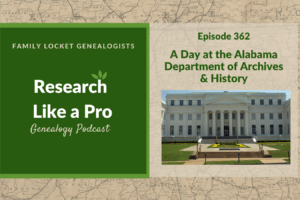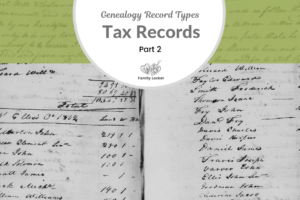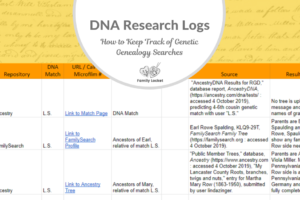
If you’ve studied tax records when tracking an ancestor, you know how much data there can be to enter. Tax records are invaluable in research because they were taken annually, filling in the years between the federal census. The challenge comes in finding a good way to track and analyze the data. Airtable is my favorite research log tool, and by adding a linked table to the log, I can tame that tax data and make it work for me. For more help using tax records, see my three-part series: Back to the Basics with Tax Records.
Case Study
My current research project centers on Dallas County, Texas, from 1850 to 1870. The new state of Texas levied a land, property, and poll tax to be collected annually, and records for Dallas County began in the 1840s. My ancestor, Henderson Weatherford, resided in Dallas County in 1860 and appears on a tax list of the same year. 1
On the same tax page are other Weatherfords, and years ago, I assigned him to this family as a probable son and brother. Returning to this project, I took a second look at my hypothesis and realized a tax study was in order. I wanted to track the Weatherfords who showed up in Dallas County by 1850—at least ten years before my Henderson Weatherford, who was in Morgan County, Missouri, in 1850.

The challenge? Many Weatherfords appear in the tax rolls for each year, and if they owned many land parcels, there was a separate row for each land holding. I started entering the data in my research log, but I realized abstracting the information into my research log was getting unwieldy. I needed to customize my Airtable base.
Customizing the Airtable Base
I’m using the RLP with DNA 4.0 (2024) Airtable base template for my Weatherford research project. I like this latest version of the Airtable research log because the timeline table is linked to the research log table. I can enter a source once in the research log table and then use that source for multiple entries in the timeline. Although this project isn’t DNA-based, I’ll be adding DNA later so I started with the DNA template and will use the DNA portions in a later project.
I decided I could use the same premise in tracking the tax records for the Weatherfords. I could create a new table for the tax records and create fields (columns) that match the tax roll headings such as person, land, value, watercourse, horses, cattle, poll, state, and county tax. This new table would be linked to the research log, where I would enter each year’s tax roll(s) and then select it for each Weatherford individual I tracked. I planned to have a separate record (row) for each land parcel.
The image below shows the first half of the Dallas County Tax Lists table. The second half continues with the number of horses, cattle, etc.

Setting up the Tax Record Table
Here are the basic steps if you’d like to customize your Airtable base to track tax records or any other type of record that has considerable data entry. I’ve done something similar for a census study that worked well.
- Start with the RLP with DNA 4.0 (2024) Airtable base template
- Add a new table by clicking the + in the list of tables
- Rename the table using your name of choice. I used “Dallas County Tax Lists.”
- Pull up a tax list and view the headings. Match the headings in the new table to the headings. Add a field for each heading. Tax lists can vary yearly, so you may want to add a miscellaneous field for anything unusual.
- Customize each field to match the heading. I used # Number for headings like “acres,” “cattle,” and “horses.” I used $ Currency for values so that I could easily see which entries were dollar amounts. I used single select for fields like the original grantee of the land and the watercourse so I could type a name once and then keep using it.
- Add a linked field (column) for the source and select the research log table to link to. Choose lookup fields that you want to automatically show up from the source, such as the citation, attachment, etc.
The image below shows the second half of the tax table. Because the source information for a tax page is entered into the research log, I can select that source for each row it brings over the URL and source citation.

Using the Tax Record Table
Now that your tax table is created, you can start entering the data. With the headings set up, the data entry will go quickly. When complete, you can use Airtable’s grouping, sorting, and filtering abilities to analyze the records.
You can group the tax table by an individual to view their economic status. Did a young man gain more land each year? More livestock? When did a person appear in the tax table? If it was a woman, was she taxed on the same land as her husband the previous year, signaling he had died? When did a young man first appear in the tax lists showing his coming of age and eligibility to pay the poll tax? You could group by watercourse to find everyone in the same general area. Perhaps you’d like to group by original grantee or sort by number of acres to see who owned the most land.
In Airtable, you can create different views by duplicating the full view and then filtering and grouping. For example, I found that William Weatherford died after the 1849 tax assessment, and Jefferson Weatherford acted as an agent in paying the taxes on his land property. William’s widow, Nancy, began to be listed in 1851. I wanted a view showing just this tax information. I duplicated the full view and then filtered it by William and Nancy. Looking at the data, I see she paid taxes on two tracts of land consistently. One tract was originally granted to C.A. Wayfield and was on the Trinity watercourse. The other tract was initially granted to James Hughs and was on the Cedar Bluff watercourse.
With the data entered, I can start to make connections among this group of Weatherfords and determine if my ancestor, Henderson Weatherford, has any connection!

Tax records are valuable in genealogy research, and adding a table in Airtable to track the complicated data may be just what you need!
Best of luck in all your genealogical endeavors!
Sources
- “Texas, County Tax Rolls, 1837-1910,” entry for Henderson, Nancy, Rebecca Weatherford, 1860, image 631, FamilySearch (https://www.familysearch.org/ark:/61903/1:1:VY1B-55K : accessed 24 July 2024.)














2 Comments
Leave your reply.